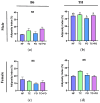Mechanisms Mediating Tart Cherry and Fish Oil Metabolic Effects in Diet-Induced (C57BL/6J) and Genetically (TALYHO/Jng) Obese Mice
- PMID: 39683572
- PMCID: PMC11644550
- DOI: 10.3390/nu16234179
Mechanisms Mediating Tart Cherry and Fish Oil Metabolic Effects in Diet-Induced (C57BL/6J) and Genetically (TALYHO/Jng) Obese Mice
Abstract
Background/objectives: Obesity is a major public health concern that increases the risk of chronic diseases. In obesity, adipose tissue undergoes remodeling, which is associated with chronic low-grade inflammation and disruption of its homeostatic mechanisms including endoplasmic reticulum (ER) function and autophagy. Fish oil (FO) and tart cherry (TC) have known anti-inflammatory properties. We hypothesized that while TC and FO individually decrease inflammation, their combined effects will be greater and will be either synergistic or additive in regulating inflammation and other adipose tissue functions.
Methods: Here, we conducted gene expression analyses, using qRT-PCR, on gonadal white adipose tissues from a previous study where male and female C57BL/6J (B6) and TALLYHO/Jng (TH) mice were fed low fat (LF), high fat (HF), or HF diets supplemented with TC, FO, or TC + FO for 14 weeks from weaning. Data was statistically analyzed by one or two-way ANOVA, using GraphPad Prism.
Results: HF diet increased adiposity and upregulated markers of inflammation, ER stress, and autophagy compared to the LF diet in both mouse models. While both TC and FO supplementation individually reduced the expression of inflammatory, ER stress, and autophagy markers on HF diet, their combination showed no consistent additive or synergistic effects.
Conclusions: Overall, our findings suggest that although TC and FO effectively mitigate inflammation in white adipose tissue, their combined use did not result in synergistic or additive effects of the two interventions.
Keywords: fish oil; inflammation; obesity; tart cherry; white adipose tissue.
Conflict of interest statement
The authors declare no conflicts of interest. The funders had no role in the design of the study; in the collection, analyses, or interpretation of data; in the writing of the manuscript; or in the decision to publish the results.
Figures











References
MeSH terms
Substances
Grants and funding
LinkOut - more resources
Full Text Sources
Medical
Research Materials
Miscellaneous

